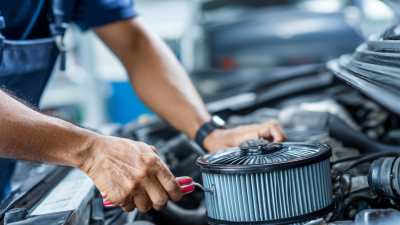Auto Repair Shop In Plainfield, IL
Understanding Mobile Transmission Repair: Common Issues and Essential Fixes Explained
 Mobile transmission repair is a vital aspect of vehicle maintenance that often goes unnoticed until problems arise. Understanding the common issues associated with mobile transmission systems, from fluid leaks and overheating to gear slippage and strange noises, is essential for vehicle owners. This guide aims to demystify these prevalent problems and provide essential fixes that can save both time and money.
Whether you're a seasoned mechanic or a car owner looking to enhance your knowledge, grasping the nuances of mobile transmission repair can empower you to make informed decisions about your vehicle's health.
By identifying symptoms early and knowing how to approach repairs, you can ensure that your vehicle runs smoothly and efficiently, prolonging its lifespan and enhancing your driving experience.
Join us as we explore the intricacies of mobile transmission repair and arm yourself with the tips you need to tackle this critical aspect of automotive care.
Mobile transmission repair is a vital aspect of vehicle maintenance that often goes unnoticed until problems arise. Understanding the common issues associated with mobile transmission systems, from fluid leaks and overheating to gear slippage and strange noises, is essential for vehicle owners. This guide aims to demystify these prevalent problems and provide essential fixes that can save both time and money.
Whether you're a seasoned mechanic or a car owner looking to enhance your knowledge, grasping the nuances of mobile transmission repair can empower you to make informed decisions about your vehicle's health.
By identifying symptoms early and knowing how to approach repairs, you can ensure that your vehicle runs smoothly and efficiently, prolonging its lifespan and enhancing your driving experience.
Join us as we explore the intricacies of mobile transmission repair and arm yourself with the tips you need to tackle this critical aspect of automotive care.
Understanding Common Mobile Transmission Issues: A Data-Driven Analysis
Mobile transmissions are complex systems prone to various issues that can affect a vehicle’s performance. Understanding these common problems can help drivers identify when their transmission may need attention. Common issues include slipping gears, delayed engagement, and unusual noises. Data shows that these issues often stem from low fluid levels, worn clutch components, or damaged bands. Regular monitoring of fluid quality and levels can aid in early detection, potentially saving drivers from costly repairs.

Tips: Always check your transmission fluid regularly; low fluid can lead to significant transmission issues. Additionally, if you notice any signs of slipping or hesitation, consult a technician promptly to diagnose the problem before it escalates.
Comprehensive analysis of mobile transmission issues also highlights the importance of maintenance. Drivers should be aware that routine check-ups can mitigate many common problems. For instance, replacing the transmission filter and fluid every 30,000 to 60,000 miles can prolong the life of your transmission. It’s also advisable to listen for any odd sounds while driving, such as grinding or whining, which can indicate underlying issues that require immediate attention. Keeping an eye on these factors can ensure smoother operation and enhance the lifespan of your vehicle's transmission.
Identifying Signs of Transmission Problems: Key Indicators to Watch For
When it comes to mobile transmission repair, recognizing the early signs of transmission problems is crucial. Drivers should be vigilant about common indicators like slipping gears, unusual noises, or a dashboard warning light. According to the Automotive Repair Association, approximately 30% of all vehicle breakdowns are related to transmission issues. This statistic underscores the importance of timely diagnosis and intervention to prevent minor problems from escalating into costly repairs.
In addition to monitoring driving behavior, it's vital to keep an eye on fluid levels and condition. Transmission fluid plays a significant role in ensuring smooth operation; dirty or low fluid can lead to overheating and further damage. The National Institute for Automotive Service Excellence recommends regular checks as part of routine maintenance. Moreover, fluctuating economic conditions can impact repair costs, with recent labor market trends showing increased pressure on pricing. Awareness of these factors can help vehicle owners make informed decisions, fostering a proactive approach to mobile transmission maintenance.
Essential Tools for Mobile Transmission Repair: What Every Technician Needs
When it comes to mobile transmission repair, having the right tools is crucial for technicians. Essential tools go beyond just basic wrenches and screwdrivers; they include specialized equipment designed to diagnose and rectify transmission issues with precision. For instance, hydraulic jacks and lifts are indispensable for accessing the undercarriage, while diagnostic scanners can provide crucial error codes that guide technicians in identifying problems quickly. Moreover, high-quality impact wrenches and torque wrenches are vital for ensuring fasteners are secured to manufacturer specifications, which is essential in maintaining transmission integrity.

In a mobile repair context, technicians often face unique challenges. They need equipment that not only works effectively but is also portable and reliable. And while investing in these essential tools is important, it is equally vital to have a deep understanding of how to use them effectively. Experience and knowledge set successful technicians apart, particularly when calibrations fail or unexpected issues arise. Therefore, continuous training and exposure to the latest technologies in mobile transmission repair can enhance a technician's ability to deliver top-notch service on the go.
Step-by-Step Guide to Diagnosing Transmission Failures: Techniques and Best Practices
Diagnosing transmission failures in mobile vehicles often requires a systematic approach to identify and fix underlying issues. By using a comprehensive step-by-step methodology, technicians can efficiently pinpoint the root causes of transmission malfunctions. This process typically starts with a thorough evaluation of the vehicle's symptoms, followed by leveraging diagnostic tools and techniques to assess the transmission’s performance. Key indicators, such as unusual noises, slipping gears, or fluid leaks, serve as critical clues in this diagnostic hunt.
Once the potential issues are identified, corrective measures can be implemented. These may involve addressing mechanical failures, replacing worn-out components, or reprogramming the transmission control unit. It's essential to combine traditional repair methods with innovative technologies, such as advanced diagnostic software, to enhance the overall efficiency and accuracy of the repair process. By integrating such approaches, technicians can not only fix current problems but also prevent future failures, ensuring a smooth and safe driving experience for mobile vehicle owners.
Understanding Common Mobile Transmission Repair Issues
This chart illustrates the frequency of common transmission issues encountered during mobile transmission repairs. The data represents the percentage of each issue as it relates to total repairs performed.
Cost Estimates for Common Mobile Transmission Repairs: Budgeting for Service Needs
When it comes to mobile transmission repairs, understanding the common issues that arise can significantly influence your budgeting process. Typical problems include fluid leaks, overheating, and gear slipping, which can all escalate if not addressed promptly. Industry reports indicate that the average cost for transmission repairs can range from $1,000 to $4,000, depending on the severity of the issue and whether a simple fix or a complete transmission rebuild is necessary. For instance, replacing a transmission might cost between $1,500 and $3,400, while minor repairs such as fluid changes or sensor replacements can be significantly more budget-friendly, often coming in under $500.
Cost estimates for these repairs vary widely based on the make and model of the vehicle, as well as regional labor rates. Therefore, it's prudent to use available tools for auto repair estimations, allowing car owners to better prepare their finances for upcoming maintenance needs. By understanding the potential costs associated with specific transmission issues, vehicle owners can make informed decisions about their repair priorities and avoid unexpected expenses that could derail their budgets. Additionally, considering routine maintenance as a preventative measure can help manage overall repair costs in the long run, ensuring smoother operations for your mobile transmission system.
Related Posts
-

Essential Guide to Mobile Transmission Repair Services and Tips for Vehicle Longevity
-

Understanding the Essential Steps for Effective Cooling System Repair
-

Unlocking the Secrets: 85% of Car Owners Overlook Essential Garage Repair Tips
-

Essential Guide to Auto Repair Help for DIY Enthusiasts and Beginners
-

Revolutionizing Your Skills: The Ultimate Guide to Auto Repair Programs for Beginners
-

Top 5 Essential Locations for Expert Transmission Rebuild Services Near You
Contact Us
Service Area
Plainfield, 60585, 60544, 60586, Naperville, 60564, Bolingbrook, 60490, 60440, Romeoville, 60446, Will, Kendall, DuPage, Counties. Our auto repair shop in Plainfield, IL, has been serving the local area plus all surrounding Chicagoland since 1978.
Specialties
• Computer Diagnostic • Brake Shop • Engine Replacement • Transmission Rebuild • Clutch Replacement • Differential Rebuild • Suspension Shop • Steering • Shocks & Struts • Heating & Cooling • Electrical • Exhaust Shop • Catalytic Converter Replacement • Alignment • Domestic & Foreign Vehicle Service • Auto Repair In Plainfield, IL • Auto Repair Shops Near Me • Towing Service Near Me

